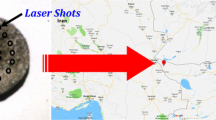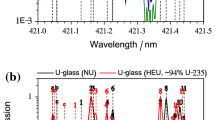Abstract
In this study, a laboratory laser-induced breakdown spectroscopy (LIBS) system was used to measure the gadolinium (Gd) content in thorium (Th) oxide matrix to investigate and assess the ability of the LIBS technique for nuclear material analysis. Five different Gd concentrations were quantitatively spiked into the Th oxide powder and analyzed by the LIBS system. Although a spectrometer with relatively limited resolution was used in the experiment, the characteristic emission lines of Gd were identified and the unresolved Gd II 348 nm-band with no interference with Th lines was selected for Gd quantitative analysis. Results show that the mathematical technique of multi-component Lorentzian Fit can be well utilized to deconvolve the unresolved spectra. Univariate calibration curves for Gd element were constructed using peak area and peak intensity methods. The best calibration curve was obtained using the peak area of the Gd 348.18 nm and yielded the lowest limit of detection (LOD) of 0.60%. The leave-one-out method was employed to further investigate the analytical prediction skills of LIBS for each reference samples. For Gd concentration \(\ge\) 4.33%, using the peak area of 348.18 nm can provide higher accuracy on the predicted concentrations. These results presented here demonstrate that the Gd element can be qualitatively and quantitatively monitored in Th oxide matrix using LIBS with a relatively limited resolution spectrometer.







Similar content being viewed by others
References
Z. Varga, R. Katona, Z. Stefanka, M. Wallenius, K. Mayer, A. Nicholl, Determination of rare-earth elements in uranium-bearing materials by iductively coupled plasma mass spectrometry. Talanta 80, 1744–1749 (2010)
P.C. Burns, G.E. Sigmon, Uranium: Cradle to the Grave. Quebec: mineralogical Association of Canada. 9,386-386 (2013)
U.S. DOE, A technology roadmap for generation IV nuclear energy systems. In: Nuclear Energy Research Advisory Committee and the Generation IV International Forum. (2002)
M.-H. Jiang, H.-J. Xu, Z.-M. Dai, Advanced fission energy program-TMSR nuclear energy system. Bull. Chin. Acad. Sci. 27, 366–374 (2012)
R. Hargraves, M. Ralph, Liquid fluoride thorium reactors: an old idea in nuclear power gets reexamined. Am. Sci. 98, 304–313 (2010)
C.-G. Yu, J.-H. Wu, C.-Y. Zou, X. Cai, Y. Ma, Thorium utilization in a small modular molten salt reactor with progressive fuel cycle modes. Int J Energy Res. 43, 3628–3639 (2019)
C.-Y. Zou, X.-Z. Cai, D.-Z. Jiang, C. Yu, X.-X. Li, Y. Ma, H. Li, J.-G. Chen, Optimization of temperature coefficient and breeding ratio for a graphite-moderated molten salt reactor. Nucl. Eng. Des. 138, 114–120 (2015)
C.-Y. Zou, C. Yu, J. Wu, X.-Z. Cai, J.-G. Chen, Ameliorating the positive temperature feedback coefficient for an MSR fueled with transuranic elements. Ann. Nucl. Energy. 160, 108325 (2021)
K. Yang, W. Qin, J.-G. Chen, X.-Z. Cai, Neutron excess method for performance assessment of thorium-based fuel in a breed-and-burn reactor with various coolants. Nucl. Sci. Tech. 27, 1–7 (2016)
B.E. Naes, S. Umpierrez, S. Pyland, C. Barnett, J.R. Almirall, A comparison of laser ablation inductively coupled plasma mass spectrometry, micro X-ray fluorescence spectroscopy, and laser induced breakdown spectroscopy for the discrimination of automotive glass. Spectrochim. Acta Part B. 63, 1145–1150 (2008)
J.D. Winefordner, J.B. Gornushkin, T. Correll, E. Gibb, B.W. Smith, N. Omenetto, Comparing several atomic spectrometric methods to the super stars: special emphasis on laser induced breakdown spectrometry, LIBS, a future super star. J. Anal. At. Spectrom. 19, 1061–1083 (2004)
D.A. Cremers, L.J. Radziemski, Handbook of laser-induced breakdown spectroscopy (John Wiley & Sons, Ltd., New York, 2006)
A.W. Miziolek, V. Palleschi, I. Schechter, Laser induced breakdown spectroscopy: fundamentals and applications (Cambridge University Press, Cambridge, 2006)
A. Ciucci, M. Corsi, V. Palleschi, S. Rastelli, Salvetti, E. Tognoni, New procedure for quantitative elemental analysis by laser-induced plasma spectroscopy. Appl. Spectrosc. 53, 960–964 (1999)
L. St-Onge, E. Kwong, M. Sabsabi, E.B. Vadas, Quantitative analysis of pharmaceutical products by laser-induced breakdown spectroscopy. Spectrochim. Acta Part B. 57, 1131–1140 (2002)
Y.-L. Yu, W.-D. Zhou, X.-J. Su, Detection of Cu in solution with double pulse laser-induced breakdown spectroscopy. Opt. Commum. 333, 598–601 (2014)
J.R. Wachter, D.A. Cremers, Determination of uranium in solution using laser-induced breakdown spectroscopy. Appl. Spectrosc. 417, 1042–1048 (1987)
M.Z. Martin, S. Allman, D.J. Brice, R.C. Martin, N.O. Andre, Exploring laser-induced breakdown spectroscopy for nuclear materials analysis and in-situ applications. Spectrochim. Acta Part B. 74–75, 177–183 (2012)
E.C. Jung, D.H. Lee, J.-I. Yun, J.W. Yeon, K. Song, Quantitative determination of uranium and europium in glass matrix by laser-induced breakdown spectroscopy. Spectrochim. Acta Part B 66, 761–764 (2011)
A I Whitehouse, J Young, C P Evans, A Brown (Applied Photonics Ltd.), J Franco, A Simpson (BNFL Instruments Inc.), Remote Characterization of HLW using Laser-Induced Breakdown Spectroscopy, Presented at: 10th International High-Level Radioactive Waste Management Conference (IHLRWM), Las Vegas, Nevada, USA. (2003)
J. Wu, Y. Qiu, X. Li, H. Yu, Z. Zhang, A. Qiu, Progress of laser-induced breakdown spectroscopy in nuclear industry applications. J. Phys. D: Appl. Phys. 53, 023001 (2020)
P. Devangad, V.K. Unnikrishnan, R. Nayak, M.M. Tamboli, K.M.M. Shameem, C. Santhosh, G.A. Kumar, D.K. Sardar, Performance evaluation of Laser Induced Breakdown Spectroscopy (LIBS) for quantitative analysis of rare earth elements in phosphate glasses. Opt. Mater. 52, 32–37 (2016)
S.S. Rai, N.K. Rai, A.K. Rai, U.C. Chattopadhyaya, Rare earth elements analysis in archaeological pottery by laser induced breakdown spectroscopy. Spectrosc Lett. 49, 57–62 (2016)
Y. Dwivedi, S. Thakur, S. Rai, Laser induced breakdown spectroscopy diagnosis of rare earth doped optical glasses. Appl. Opt. 49, C42–C48 (2010)
C.R. Bhatt, J.C. Jain, D.L. McIntyre, Investigating the CO2 pressure effect on underwater laser-induced plasma emission of Eu and Yb. Spectrochim. Acta, Part B 149, 42–47 (2018)
S.S. Harilal, P.K. Diwakar, N.L. LaHaye, M.C. Phillips, Spatio-temporal evolution of uranium emission in laser-produced plasmas. Spectrochim. Acta Part B. 111, 1–7 (2015)
M. Martin, R.C. Martin, S. Allman, D. Brice, A. Wymore, N. Andre, Quantification of rare earth elements using laser-induced breakdown spectroscopy. Spectrochim. Acta Part B. 114, 65–73 (2015)
A.A. Galahom, M.-Y.M. Mohsen, N. Amrani, Explore the possible advantages of using thorium-based fuel in a pressurized water reactor (PWR) Part 1: Neutronic analysis. Nucl. Eng. Technol. 54, 1–10 (2022)
M. Lovecký, J. Závorka, J. Jiřičková, R. Škoda, Increasing efficiency of nuclear fuel using burnable absorbers. Progress Nucl. Energy. 118, 103077 (2020)
R.C. Chinni, D.A. Cremers, L.J. Radziemski, M. Bostian, C. Navarronorthrup, Detection of uranium using laser-induced breakdown spectroscopy. Appl. Spectrosc. 63, 1238–1250 (2009)
A. Williams, S. Phongikaroon, Laser-induced breakdown spectroscopy (LIBS) measurement of uranium in molten salt. Appl. Spectrosc. 72, 1029–1039 (2018)
National Institute of Standards and Technology (NIST) database. https://www.nist.gov/PhysRefData/ASD/lines_form.html
Atomic spectral line database from CD-ROM 23 of R. L. Kurucz. https://lweb.cfa.harvard.edu/amp/ampdata/kurucz23/sekur.html
J.E. Barefeld, E.J. Judge, J.M. Berg, S.P. Willson, L. Le, L.N. Lopez, Analysis and spectral assignments of mixed actinide oxide samples using laser-induced breakdown spectroscopy (LIBS). Appl. Spectrosc. 67, 433–440 (2013)
I. Choi, G.C.-Y. Chan, X.-L. Mao, D.L. Perry, R.E. Russo, Line selection and parameter optimization for trace analysis of uranium in glass matrices by laser-induced breakdown spectroscopy (LIBS). Appl. Spectrosc. 67, 1275–1284 (2013)
C.A. Smith, M.A. Martinez, D.K. Veirs, Cremers, A. David, Pu-239/Pu-240 isotope ratios determined using high resolution emission spectroscopy in a laser-induced plasma, Spectrochim. Acta Part B. 57, 929–937 (2002)
K. song, H. Cha, J. Lee, Y.I. Lee, Investigation of the line-broadening mechanism for laser-induced copper plasma by time-resolved laser-induced breakdown spectroscopy, Microchem. J. 63, 53–60 (1999)
S. Merk, A. Demidov, D. Shelby, I.B. Gornushkin, U. Panne, B.W. Smith, N. Omennetto, Diagnostic of laser-induced plasma using Abel inversion and radiation modeling. Appl. Spectrosc. 67, 851–859 (2013)
Acknowledgements
This work is supported by the National Natural Science Foundation of China (No. 12005037) and Fundamental Science on Radioactive Geology and Exploration Technology Laboratory (No. RGET1911).
Author information
Authors and Affiliations
Contributions
XL and YR wrote the main manuscript text, XL, JL, CX and XL did the experiment, YL and SS prepared Figs. 1–7. All authors reviewed the manuscript.
Corresponding author
Ethics declarations
Conflict of interest
The authors declare that they have no conflict of interest.
Additional information
Publisher's Note
Springer Nature remains neutral with regard to jurisdictional claims in published maps and institutional affiliations.
Rights and permissions
Springer Nature or its licensor holds exclusive rights to this article under a publishing agreement with the author(s) or other rightsholder(s); author self-archiving of the accepted manuscript version of this article is solely governed by the terms of such publishing agreement and applicable law.
About this article
Cite this article
Liu, X., Rao, Y., Liu, J. et al. Quantitative analysis of gadolinium in thorium oxide matrix using laser-induced breakdown spectroscopy. Appl. Phys. B 128, 192 (2022). https://doi.org/10.1007/s00340-022-07914-8
Received:
Accepted:
Published:
DOI: https://doi.org/10.1007/s00340-022-07914-8




